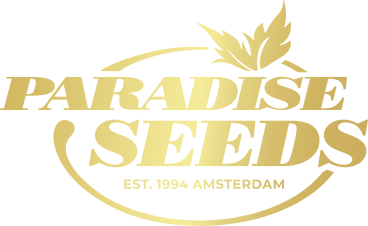Cannabis pests and mold are amongst the most common conditions Googled by growers who are having problems with sick weed plants.
These enemies of a successful cannabis harvest have the potential to cause huge problems in a grow. At best they will have an impact on yield, while at worst they will lead to the whole crop being destroyed.
This article takes a look at common cannabis pests and mold types, examines how to identify them and considers potential solutions to the problem.
Contents
Cannabis pests and mold issues overview
Cannabis pests and mold on a cannabis crop are a headache for the grower because they can quickly infest and easily overwhelm a plant.
Signs of a pest problem are usually spotted via leaf damage, with discolored or damaged leaves (marked with spots and pin-prick holes). Stunted plant growth is another sign that a plant is affected by pests.
Any plant damage needs to be investigated thoroughly in order to eliminate other potential causes, such as nutrient deficiencies.
While some pests will be obviously visible, others are tiny making a magnifying glass essential! If you suspect pests, but cannot see obvious signs, a good tester is to hold a white piece of paper under plant leaves, give them a tap and see what falls.
What are the most common pests?
Spider Mites: Up close these cannabis pests are like little spiders. They suck a plant’s sap, causing yellow or white spots on leaves and weave fine webs on the undersides of leaves. A serious spider mite infestation can destroy a crop.

Aphids: They secrete a sticky substance called honeydew, which can lead to the development of mold. They can be identified by their pear-shaped form. Aphids will often cluster on new cannabis plant growth and typically are present on the undersides of leaves.
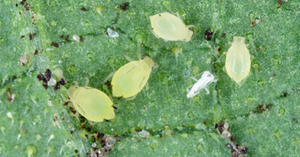
Whiteflies: These are white-winged insects that feed on plant sap, weakening the plant and causing yellowing leaves. If you see small flies flying up from a plant when it is disturbed then there is a good chance it is whitefly.
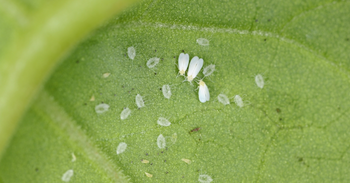
Thrips: They can be yellow, brown, or black, but you will need a magnifying glass to see them. They feed on plant tissue, creating damage on leaves and buds. Look out for silvery streaks or black spots (which are actually faeces) on leaves.
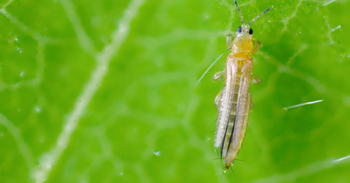
Fungus Gnats: Small, dark flies whose larvae live in the soil and feed on roots, leading to stunted growth and weakened plants. Signs of fungus gnats in your crop are winged insects which look like slow flying mosquitos (or signs of activity in the soil).
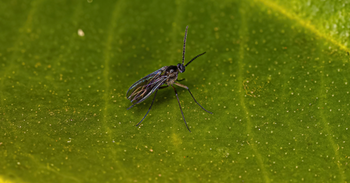
Caterpillars: Various types of caterpillars can feed on cannabis leaves and buds. These are easy to spot, but it’s difficult to pick them all off as caterpillars are very good at hiding themselves.
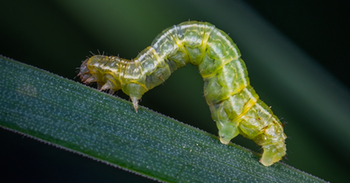
Mealybugs: These are white, cottony insects that cluster on stems and leaves, feeding on plant sap and excreting honeydew, which can promote mold growth. Mealybugs are tiny and can be white, pink, or gray. They cluster around leaf joints and under leaves.
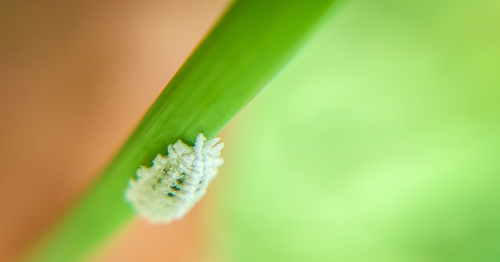
Root Aphids: These are similar to regular aphids but they target roots instead of foliage, causing yellowing and wilting of plants due to reduced nutrient uptake. In recent years, the rice root aphid has also emerged as a new threat on cannabis crops in indoor grow spaces in North America.
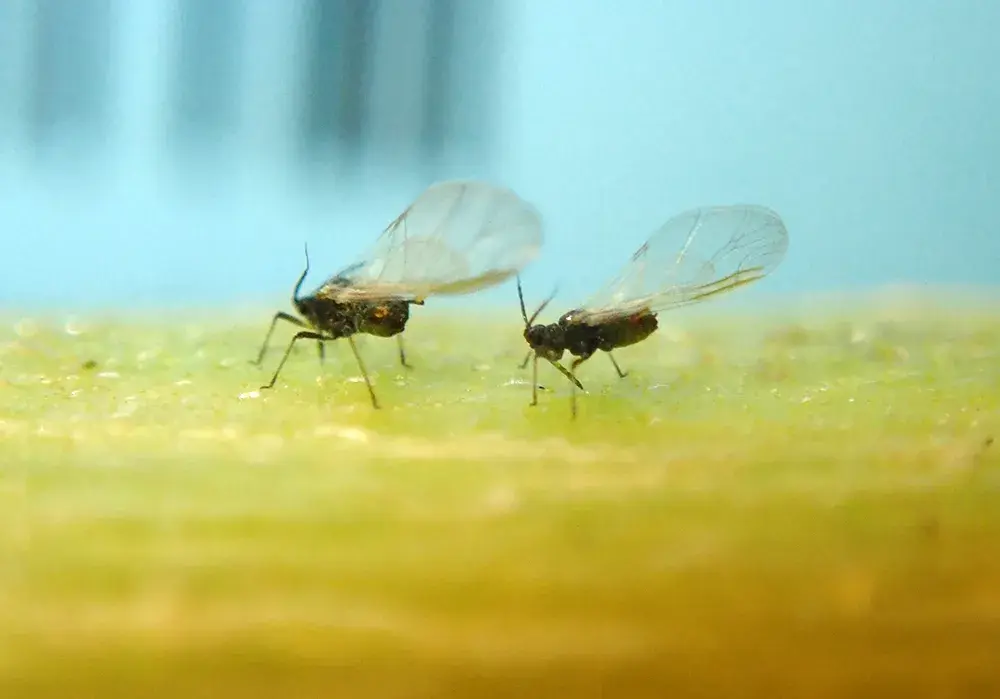
Slugs and snails: Gastropods have very tiny mouths so won’t do huge damage in one session, but they will return and as they will destroy foliage faster than it grows. They are a real issue for outdoor growers in more temperate and humid regions. Read our in depth guide on how to deal with slugs and snails.
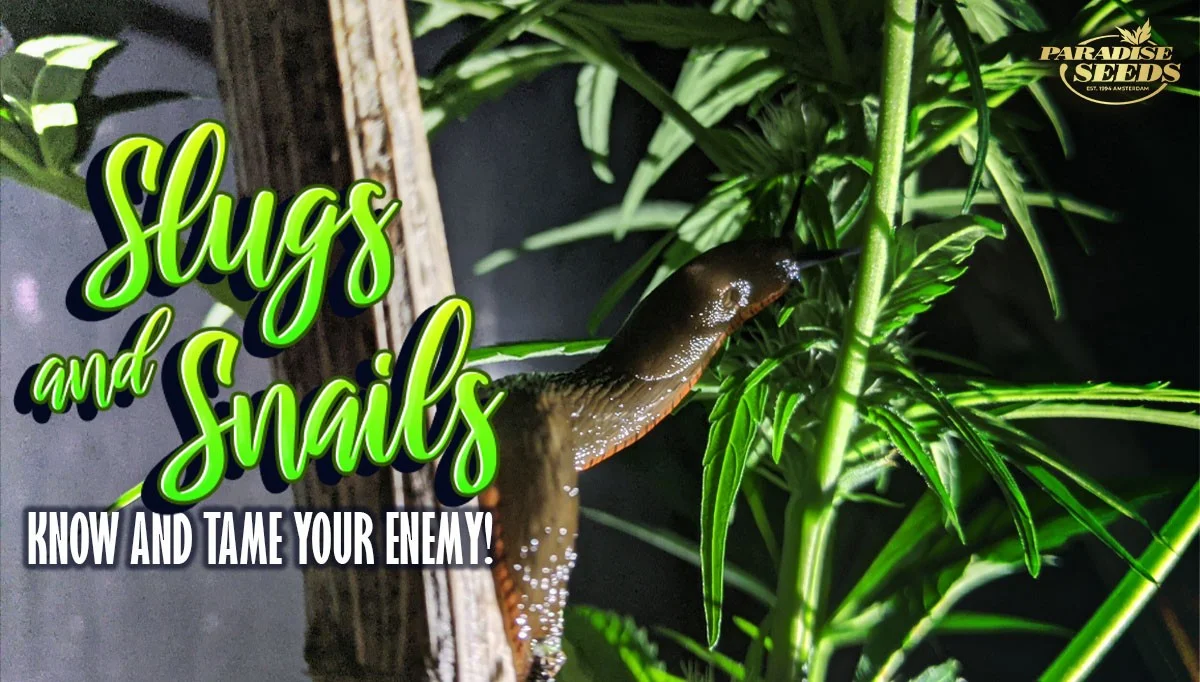
The key to preventing pests and disease is:
1) Keeping plants as healthy and strong as possible.
2) Keeping the grow space clean. This means removing plant waste.
3) Regular monitoring of plants for early signs. The quicker you identify a pest problem, the easier it is to deal with it.
Controlling pests through an Integrated Pest Management System (IPM)
To control pests and mold, growers are increasingly adopting an Integrated Pest management System or IPM. This is a holistic strategy for managing crops which focuses on long-term prevention and control through a combination of different techniques and factors.
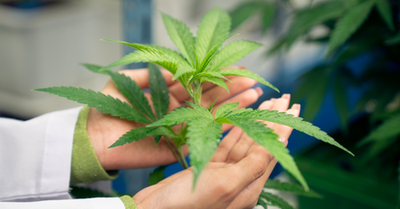
The aim is not to go all-out with chemical pesticides, but to coordinate several different organic based management techniques. It accepts that pests are part of the eco system but, with the right management, their levels can be maintained and will not result in the destruction of any crop.
The major elements of IPM
- Using natural predators, parasites, and pathogens to control cannabis pests. For example, introducing ladybugs to control aphids and predator mites to control red spider mites. These can be brought from a reputable company like Koppert, a Paradise Seeds partner in the MCPIR project.
- Optimizing the grow conditions (using light, temperature and humidity) to make it an unattractive place for pests to thrive in. They tend to thrive in conditions where temperature is above 26°C and with lower levels of humidity.
- Getting into the habit of constantly monitoring and observing plants so as to identify pest problems early and take swift action to prevent them spreading.
- Managing the cultivation environment to make it less pest-friendly. This involves growing known weed strains with good resistance qualities (such as Wappa and White Noise) and practising good hygiene in the grow room.
- Using physical methods to reduce or eliminate pests, such as traps, barriers, mulches, and manual removal of pests (such as slugs and snails).
- Ensuring plants are strong and healthy in the first place so as to deter pests. Weak plants outdoors plants are particularly susceptible to pests. Here’s a good guide to outdoor pest prevention.
- Companion planting is a good way of utilizing plants which deter pests from taking up home in your weed crop.
Cannabis mold explained
Cannabis plant molds come in various forms, and each one has the potential to harm not only the plant, but your health.
Common types of cannabis mold include powdery mildew, which is a white, dusty fungus, downy mildew, which develops on the undersides of leaves botrytis, which many growers will know as ‘bud rot’ and Aspergillus, a toxic mold that can cause severe health issues if inhaled.
Botrytis (Gray Mold, Bud Mold)
When discussing cannabis pests and mold, botrytis is the most common type of mold to affect weed plants and there are believed to be about 30 species in the family. Also known as ‘gray mold’ and ‘bud rot’, it is a very efficient enemy.
It thrives in high moisture environments and clings to wet surfaces. It focuses on vulnerabilities in cannabis plants – targeting any wounds and lesions or older bits of the plant.
Botrytis has millions of microscopic spores that spread via wind (or grower induced plant movement) and water dispersal and will often spread to surrounding plants.
What does botrytis look like?
Botrytis typically appears as a grayish-brown, fuzzy mold on buds. As it starts inside the bud it is difficult to detect until it has spread significantly.
It particularly affects big top buds, which is why training techniques are recommended by many growers to create an even bud distribution (a more even covering of medium sized buds across the plant).
Initial signs of botrytis are discolored brown/gray patches on buds, a bit like a bruising on a fruit, or a tell tale dead looking sugar leaf protruding from the bud.
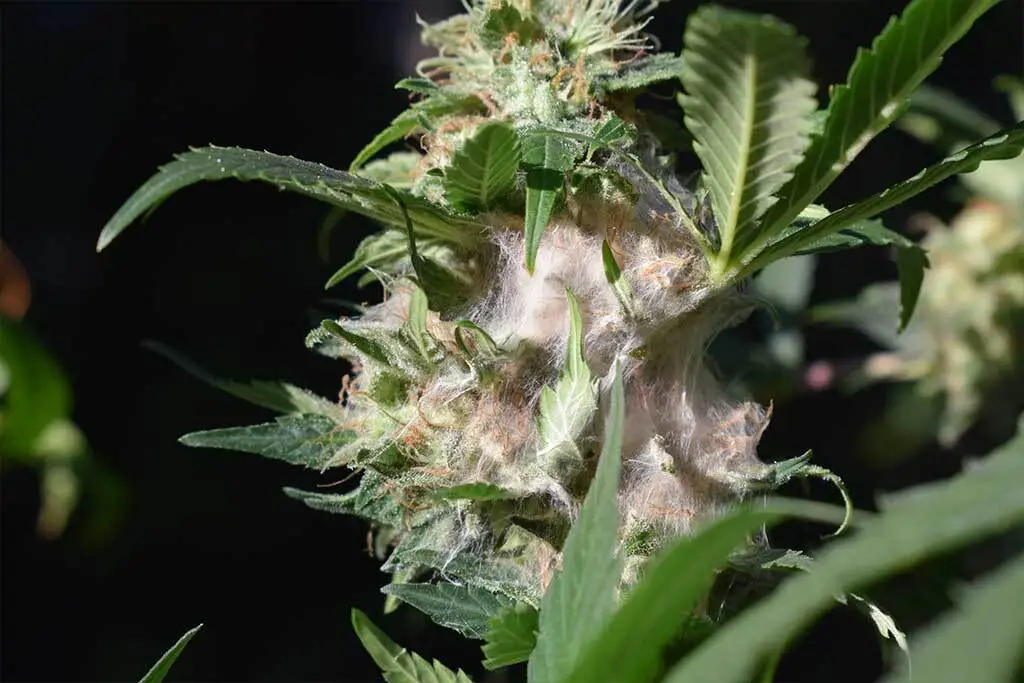
What to do if botrytis is detected?
Once detected, botrytis is like a ticking time bomb. You need to treat the issue immediately by removing infected sections, using sterilized scissors and destroying all infected buds.
You can try to treat the mold using an organic fungicide (also see below for homemade mold treatments), but be aware that mold releases thousands of spores so spreads quickly.
If mold has been identified, keep plants under close observation. If there are signs of the mold spreading, crop the plant as soon as possible.
White Powdery Mildew
White powdery mildew (aka WPM) is another common cannabis pests and mold issue.
White powdery mildew thrives in grow spaces with a high humidity content and will affect weed plants in the veg stage as well as flowering. The leaves of affected plants will start to discolour and wilt.
What does WPM look like?
It looks as though someone carrying a bag of flour or icing sugar has brushed past your plant, leaving leaves with a white sprinkle or patches of white discoloration.
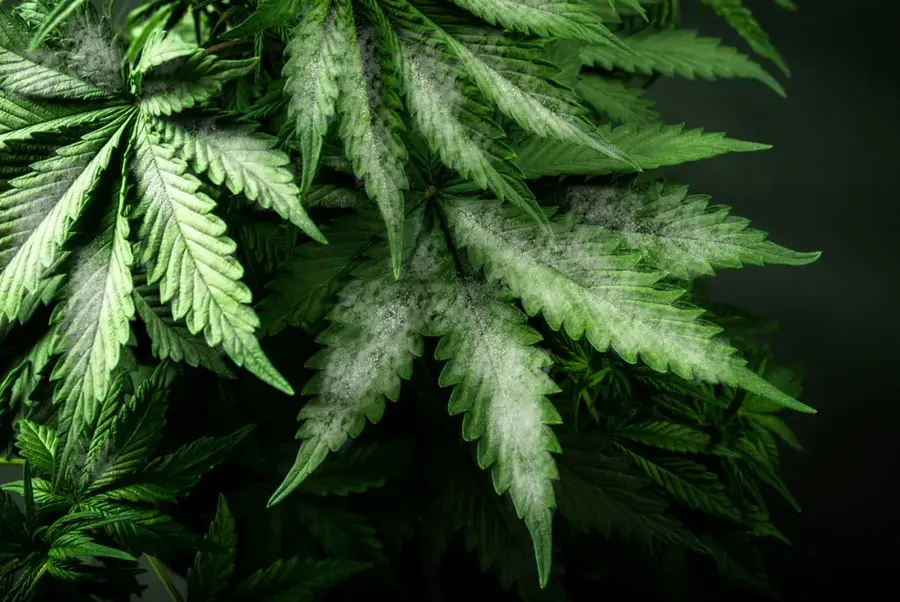
What to do if white powdery mold is detected on cannabis plants?
Remove infected leaves (carefully to avoid spreading spores). Make sure humidity is below 50% in a grow room and, especially for outdoors where this is difficult, try to improve air circulation by pruning plants to boost airflow.
Downy Mildew
Downy mildew is an issue because it usually develops on the underside of leaves and therefore is not obvious. It thrives when there are cooler temperatures and higher levels of humidity so is more common in outdoor grows. It can be fuelled by cool, wet summers.
What does downy mildew look like?
Spores establish themselves on the under side of leaves creating white, grey or yellow patches that have a lichen like appearance. As the downy mildew takes hold, the top of leaves become blemished, showing yellow spots, with brown center markings.

What to do if downy mildew is detected on cannabis plants?
Remove infected leaves (and in extreme cases the whole plant) far away from the crop. Reduce humidity in the grow room, ensure good air circulation and treat with an organic fungicide if necessary. For outdoor growers, spray solutions made from milk or bicarbonate of soda (see recipes below) can be used for treatment.
Aspergillus
If not properly managed, cannabis grown indoors can create conditions favorable for Aspergillus growth. Such factors are high humidity, temperature fluctuations, and poor ventilation.
What does Aspergillus look like?
Aspergillus is harder to detect because it may not be obvious to the eye on a plant
inspection. Tell-tale signs that Aspergillus has infected your weed plants may be a musty
smell (sometimes described as ‘earthy’) and yellowing or browning of leaves, which can be confused as a nutrient deficiency, or lack of vigor.
There is also a risk of Aspergillus developing in wet buds in containers which is why moisture control is essential in the post-harvest dry and cure process.
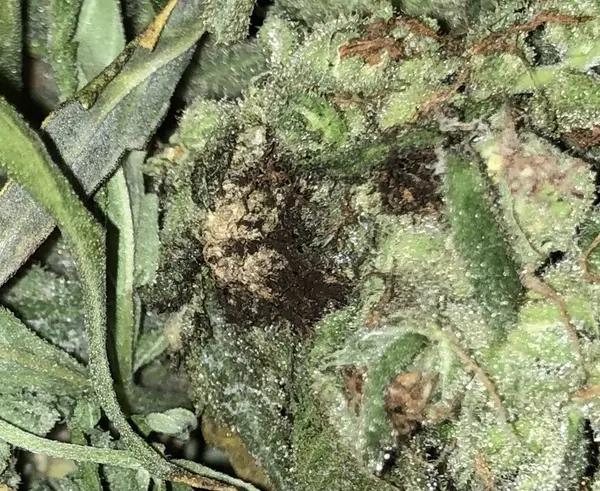
What to do if Aspergillus is detected on cannabis plants?
Destroy the plant. Consuming Aspergillus is an extreme health risk. However the issue will be spotting it.
Tips for preventing cannabis mold
Controlling climate and environmental conditions is the best defense against mold. This is better achieved with an indoor grow, but there are steps you can take to decrease the risk of mold in an outdoor grow.
Choosing a naturally mold resistant cannabis strain to grow will also provide some protection against mold.
Conditions Mold loves:
- Poor air circulation.
- Surface moisture on plants.
- High air humidity.
Conditions Mold hates:
- A clean growing area without dead plant matter and debris on the ground.
- Good airflow – spacing plants out so leaves don’t touch and thinning out plant leaves as harvest approaches are good preventative measures.
- Dry surfaces. Difficult to achieve with outdoor growing but, growers will try – everything from transparent plastic covers to protective tarpaulins.
Homemade Mold Treatments
While there are many mold treatment products on the market in the form of organic fungicides, the following suggestions are based on elements you can find in the home kitchen and are safe to use:
Milk as a cannabis mold treatment
Around 20 years ago, a Brazilian scientist made the discovery that milk could be an effective anti-mildew and mold treatment as it is known to kill off micro-organisms and also provides beneficial potassium phosphate which boosts plant defenses.
While trials of this theory have focused on alternative crops, some weed growers swear by the milk treatment, although the solution should be weak as there is a suggestion that proteins and sugars in the milk can actually induce botrytis in flowering plants.
Recipe: 90-100 ml x milk to 1 x liter of water.
Using Bicarbonate of Soda as a mold treatment
Spraying cannabis plants with a solution made up of this common kitchen cupboard item is said to make the pH of plants (and leaf surfaces, when sprayed) more alkaline making a less hospitable environment for mold to grow.
Recipe: Add 1 x tablespoon of bicarbonate of soda to 1 x liter of water.
When to apply treatments
For treating mold in the veg stage (such as powdery mildew), making up a milk or bicarbonate of soda solution and spraying it on the leaves is a good way to go.
If your plants are already in bud, then add the solution to a feed instead. Some outdoor growers who grow weed in environments where mold is a common problem will even do this as a preventative measure in the first few weeks of flowering.
** Never risk smoking moldy buds. They are toxic and potentially extremely harmful to health. It’s really not worth the risk.
Conclusion
To summarize, finding effective ways to manage cannabis pests and molds is a challenge for all growers.
Mainly environmental factors – both permanent and temporary – will contribute to pest problems and mold issues. Therefore the grower must always be prepared to react and respond to potential new threats.
However it’s worth noting that if you sow successive crops and the same problems keep returning then there is a chance that this is a particular vulnerability in your grow space.
As shown in this article, adopting a proactive strategy such as employing an Integrated Pest Management system is probably the most effective approach to minimizing the threat and damage caused by cannabis pests and mold.
